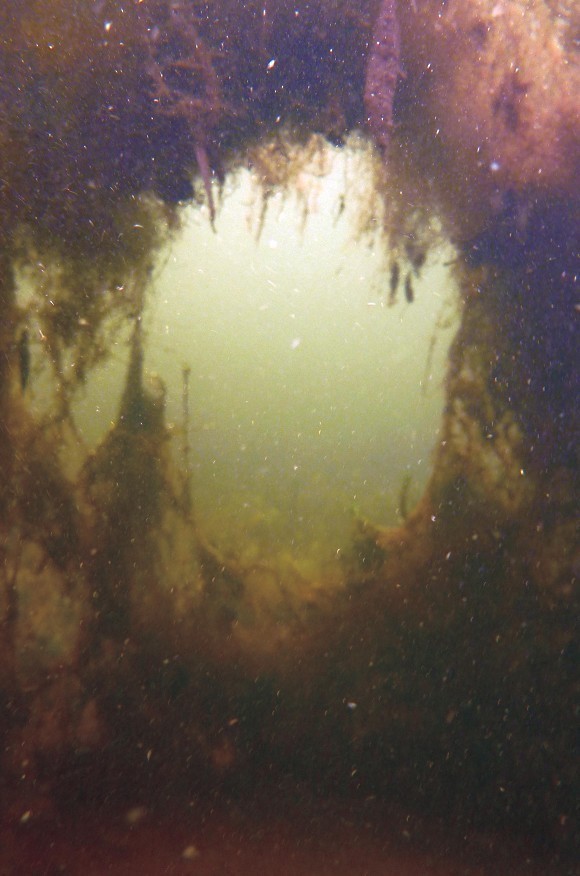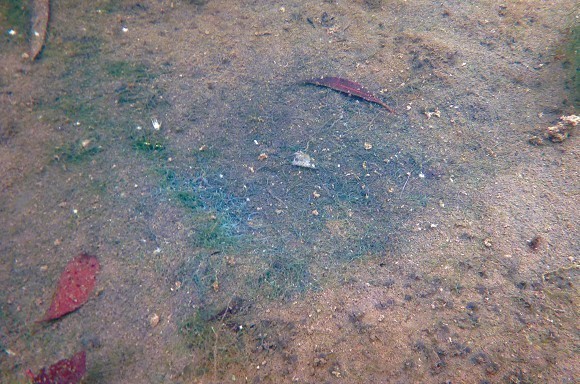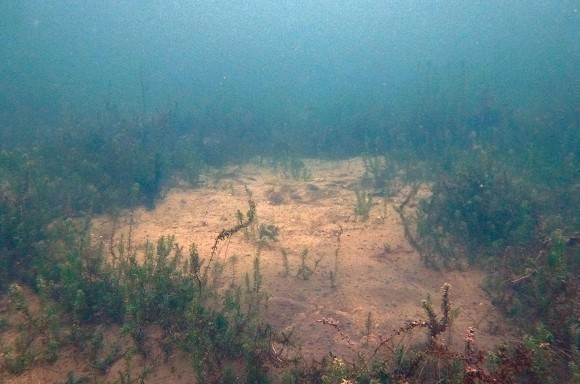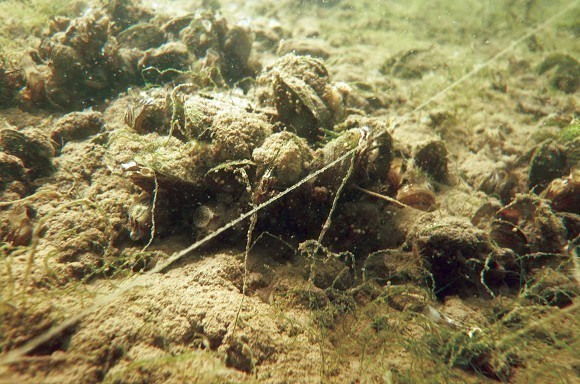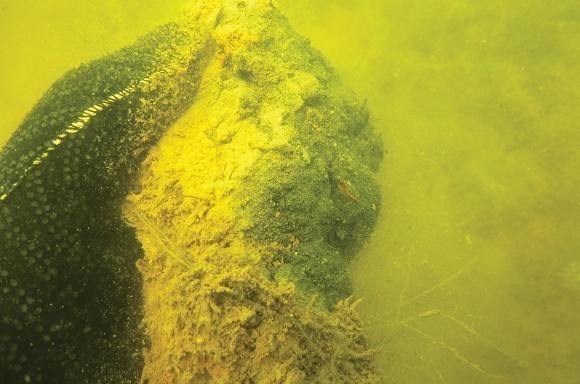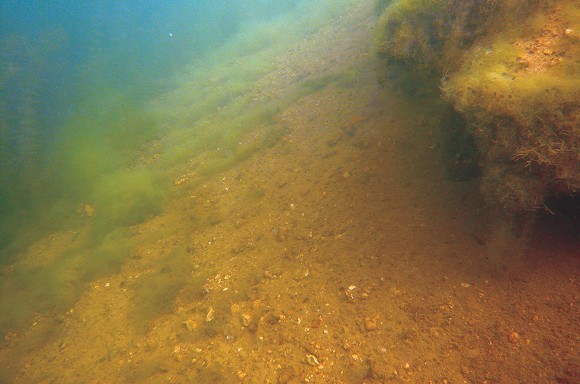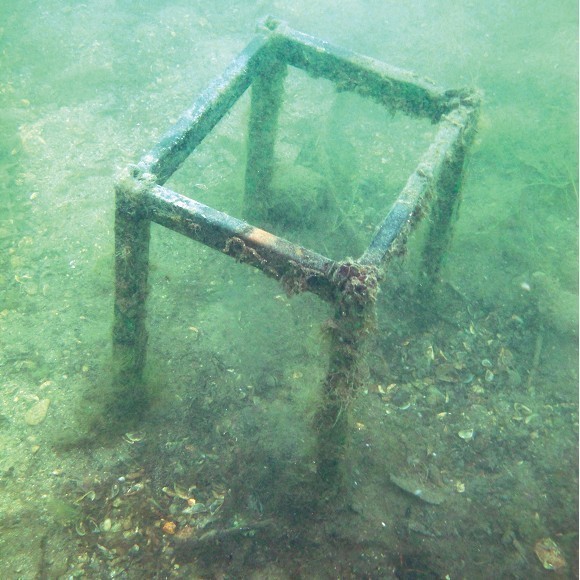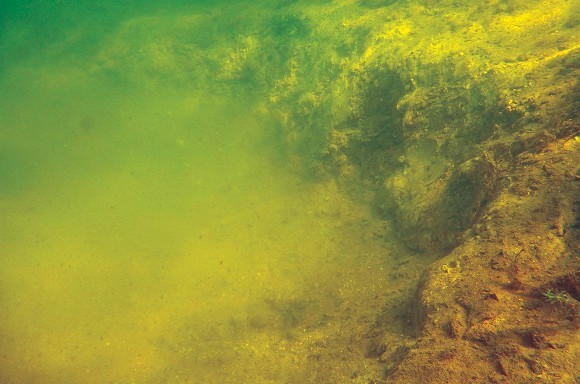
Rob Hughes' top 8 underwater observations
This month, Rob Hughes, our diving expert, reveals his top eight underwater observations, along with some tips/edges on how you can cash in on this knowledge
1 Clay holes/pits
At this time of year in particular the carp seem to love to dig around for clay. If your lake is clear enough you will no doubt see carp with muddy marks on their flanks and originally we thought that this was a result of the carp scratching off parasites in spring. It may of course be part of the reason for them rubbing or scratching, but it was Mark Holmes I believe who first suggested that they were digging for minerals in the clay to supplement their diets after a winter without. It’s interesting that the carp I have seen with clay marks on them are all during the early season, which could corroborate both views, but some of the holes and pits that I have seen carp dig lead me to believe it is more than simply scratching. After all, they could do that on anything.
I’ve seen pits as big as groundsheets and 2-3ft deep. And they generally have one thing in common: at the bottom it is clay. Not silt, not gravel, not stone but clay. Why do they search it out so much? Maybe it simply feels good on their skin or maybe they are after something in the ground that they can’t get anywhere else. Holmesy thinks it’s a mixture of salts and minerals. I tend to think he might be right, but one thing’s for sure, from my perspective I’ve seen plenty of these holes and in the spring the carp won’t be far away so a bait presented in/near one has a good chance of being spotted.
2 Weed caves
This is a very interesting phenomenon which I have seen only a couple of times. From above the water, a weedbed looks simply like a weedbed but when I get to ground level and have a look at them more closely, a large weedbed may not be what it seems. Tunnels and tracks are obvious, but on a couple of occasions, one in Abbey Lakes’ Heron Lake over in France and the other at Thorney Weir in the Colne Valley, I have come across what I would class as a ‘carp cave’. It’s literally a big lump of weed that is hollow inside and on one occasion it actually had three carp in it and on the other it had evidence that carp had recently been there. On both occasions the cave had a roof and two exits and on both occasions the floor of the cave was completely clean sandy gravel, whilst outside was a mixture of high and low lying weed.
The one in Abbey I first found whilst out lamping with a torch from a boat as it would have proven impossible to identify in normal light and when I went back to investigate in the daylight underwater it was impressive. It looked like an open fronted bivvy and wasn’t far off the same size!
The second one was during Jack Brown’s BTS feature last year and this was much more interesting. As you can see from the piccie, it looked a bit like a space invader and had entrances and what looked like a window in the back. Sadly there is no way of knowing these exist without getting wet and having a look, but they are areas where the carp will visit frequently, lie up and feel secure.
3 Carp tracking
Not necessarily a direct feature to look out for but I wanted to drop this one in so you can understand where I am coming from when I talk about what I am seeing and how I see it.
Obviously I spend a lot of time underwater, and the underwater world is similar in ways to that above the water. I’m constantly on the look-out for where carp are or where they have been, and a bit like a tracker hunting his prey, I do the same thing with fish. It’s incredible what you can see if you know what you are looking for. A skilled countryman looking at a wood will see the tracks where animals pass, often being able to detect which way they go and even how long ago they were there whilst most people will just see trees and bushes.
On numerous occasions I’ve seen the tell tale marks left by fish, be it bent over or pushed apart weed stems showing a route into or out of weedbeds or disturbed silt on the bottom of the lake showing where they have recently fed or visited. A disturbance of the light dusting of silt is probably the biggest give away or recent movement that they’ve been there.
All lakes have solids suspended in the water which settles on the bottom, covering everything with a light coating of dust. If something moves near it or feeds on it, the dust is moved just like it would be if you run your finger across the top of the telly (get cleaning more!). This is an obvious give away as to fish behaviour and feeding patterns.
4 Weedbeds
I’ll make a differentiation straightaway between weedbeds and caves. Caves are where they will get into and feel secure, weedbeds are something they will loiter round and feed off. I’ve put together a more in-depth feature on weed for the Summer Special edition of CARPology (on-sale 8th May), but what I will say is that if there is weed in your lake it pays to assume that there is more on your spot than you think there is.
Weed comes in all sorts of sizes, shapes and varieties so if you can get a bit more of an understanding on what sort it is, you should be able to fish in or around it more effectively. Unless it is top to bottom Canadian, don’t always assume that there aren’t any clear spots as, on gravel pits especially, there can be perfectly clear spots right next-door to hefty weedbeds.
Holes in the weed are another great place to place a bait, especially if the weed is slightly lower lying, but the only way you will find these small holes is with a marker, a lead or a lucky cast (which probably won’t be repeated). I regularly see fish swimming round weedbeds or simply loitering around them, and I’ll give away a little edge by saying that a lot of the time they are usually mid-water when they swim round them. Use that information as you wish, but always be safe…
5 Gravel
Apart from a buzzer screaming out the imminent arrival of a carp (hopefully), the next most satisfying thing in carp fishing is the tap, tap, tap of clean gravel or the donk of a clean, firm bottom. However, there are a couple of pointers that you might like to consider before assuming that it is gravel you are fishing over.
I’ve seen top anglers read gravel wrong on a number of occasions. If the lake is an older gravel pit and there is a known mussel population, areas that you think are gravel may not be… they might be mussels. Mussel beds feel very similar although there is a slight difference as they tend to be very tightly packed and the tap, tap, tap is very fast. Stones on the other hand have the slower tap, but the biggest one to catch us out is a light layering of silt over the top of a decent bed of gravel.
Silt, especially the Cotswold and Oxfordhsire variety, is very fine and can sometimes be very hard to read. Taking your time with a float or a lead is the best way to try and ascertain the thickness of the silt over the gravel and this will only be apparent on the drop. Once the lead has fallen through the silt, it can be pulled back easily and will be bouncing along on the gravel underneath sending you back the wrong message.
6 Silt
I’ve done a few road shows and talks this winter and on three different occasions after the show had finished, someone came up to me and said the biggest thing they picked up was that silt is not black. It seems it’s still a common misconception that silt is black (although regular ‘Ology readers will know this is not the case at all) and that is fuelled by tackle manufacturers making ‘Silty Black’ end components. To clarify the position, the decaying anaerobic silt that is below the surface is black whereas the silt on the top is covered by a layer of lighter coloured stuff and you can see from the piccie here the difference in colours between the layers. This is Cleverley Mere in Essex and if you look carefully into the black stuff you will see a bloodworm. This is where the bloodworm live and another misconception is that the bloodworm tend to hang-out of the silt-like seaweed. They may well do, but I’ve never seen it. Then again, I have only been diving almost every week through the warmer months for the last 10 years or so.
Going back to silt colours, if you are into camouflage, then bear in mind the colour of the ground around you when thinking about your rig components. ‘Weedy Green’ and ‘Silty Black’ may sound ideal but not necessarily where you are fishing. Have a look at the local stone as this is what colour the bottom is likely to be. In the Cotswolds it’s yellowy, in Essex it is slightly more orange and in the Midlands is significantly darker. The other thing to consider, and this goes hand-in-hand with the gravel bit above, is that you need to know how deep it is, especially if it is light.
7 Bars and bumps
Gravel pits, particularly those around Oxfordshire where I spend a lot of my time, really are wonderful places to dive. They are stuffed full of features such as bars and gullies, lumps and bumps and what I regularly have noticed is that they are almost always random. There can be a lump in the middle of nowhere for no apparent reason. Bars can stop suddenly, get steeper, narrower, smaller or open out into plateaux. There can be holes and flat spots on steep sided bars and there can also be steep drop-offs on bars themselves.
Generally, towards the top of a bar, unless it is quite wide and flat, there is usually very little silt. As you come down the sides it tends to be sandier and there are very frequently steps. This can sometimes be caused by undertow, erosion or simply the passage of time, but a lot of the time, especially in the areas I have mentioned, they are caused by crayfish. They can undermine whole areas and like to burrow into the sides of bars creating interesting features but they can equally cause you lots of problems.
Crays generally don’t burrow in the tops as they like a roof over their heads, and they can dig out quite substantial holes and create flat areas that look like badger sets. Interestingly, the bigger males tend to have quite large territories in which they live and there will be no others in the immediate vicinity. When we look in the edge and see lots of small crays we can conclude the place is snitching with them. Generally it isn’t. The bigger populations are in the edge as they are driven out of other territories and colonise the margins.
Bars are seldom regular rises and falls and will often have weed on or around them so have a good plumb around as there may well be something interesting, or equally disastrous, not far away.
8 Other stuff!
It’s amazing what you see in lakes. I’ve seen submerged buildings, cars, push bikes, shopping trollies, public telephone box coin bins and even large pipes and tables on the bottom. People chuck stuff in. The margins are obviously the places where there are likely to be most “things” and they can cause a problem or two if you are not too sure what they are. That feature you thought was a nice hard lump might well be the roof of a car and that snag may well be a shopping trolley. If the area is generally devoid of other features they might draw fish to them, but I’m more of the opinion that the carp tend simply to ignore the “whatever it is” and get on with their lives.
ROB HUGHES



